Tuesday, October 11, 2005
EBay's PayPal to buy VeriSign unit for $370 mln
SAN FRANCISCO (Reuters) - EBay Inc.
The move was seen as letting PayPal, already the largest online payments company, expand faster beyond its core audience of eBay-based transactions and to compete better with credit cards as an online-payment system, analysts said.
VeriSign's payment gateway software connects Web businesses with payment processors generally run by major banks. VeriSign also is the dominant supplier of software used to manage secure credit card transactions between consumers and Web sites.
PayPal said the payment gateway business would generate an incremental $100 million of revenue for it in 2006.
VeriSign Inc.
Shares of eBay were unchanged, after closing up 56 cents, or 1.4 percent, to $40.46 in Nasdaq trading ahead of the news.
SECURITY TOKENS
As part of the deal, eBay will buy up to one million tokens from VeriSign that display constantly-changing numbers used as passwords to increase security. So-called 'two-factor authentication' relies on a set password and a number from the token, which is synchronized with a central server.
Rival RSA Security Inc.
"We are working furiously to make customers as safe as they can be and to give them the tools to make their transactions as secure as possible," Jeff Jordan, PayPal's president, said in a phone interview.
PAYPAL EXPANSION
Legg Mason analyst Scott Devitt said the deal promises to give PayPal a leg-up in becoming the accepted payment mechanism system on VeriSign's 100,000 or so small business sites.
"Strategically the deal absolutely makes sense," and was at a favorable price, relative to revenue acquired, for eBay.
VeriSign's payment software system -- which handled more than $40 billion in payments during 2004 -- will help PayPal expand its push into the merchant services market, analysts said.
Two-thirds of PayPal's $6.5 billion in payment transactions were done on eBay during the second quarter. EBay wants to expand the remaining third, called merchant services.
"Given the early stage revolt among retailers against rising credit card processing fees, particularly among online retailers, we believe PayPal is well positioned to take share in this market," CSFB analyst Heath Terry said in a note to investors.
Some 22 percent of U.S. e-commerce transactions passed through the VeriSign software gateway in 2004, eBay spokeswoman Amanda Pires said. PayPal payments accounted for 9 percent of e-commerce payment service volumes, she said.
The gateway competes with software from CyberSource Corp.
At the agreed price, the deal with Verisign is unlikely to stir up concerns like those that followed Ebay's previously announced agreement to acquire Web communications company Skype Technologies for up to $4.1 billion, Devitt said.
Some investors questioned whether Skype's revenue and profit outlook were strong enough to justify the price, and why auctioneer eBay should get into Web telephony.
The VeriSign gateway business should generate a 20 percent operating margin, based on a pro-forma calculation that assumes the two companies had been merged for a full year, the companies said. More financial details will be provided when the deal closes, which executives said they expected to occur this quarter.
source:http://today.reuters.com/PrinterFriendlyPopup.aspx?type=ousiv&storyID=uri:2005-10-11T012150Z_01_BAU073533_RTRIDST_0_BUSINESSPRO-VERISIGN-PAYPAL-DC.XML
Supersonic jet launch 'successful'
Japan has hailed the test of a supersonic jet in South Australia's outback as a success.
The model of the supersonic jet, planned to be a successor to the Concorde, was launched from a site near Woomera in SA's north about 7am CST today.
The last test flight of the Japan Aerospace Exploration Agency (JAXA) jet ended disastrously in 2002 when the unmanned prototype model crashed to earth and exploded moments after being launched.
But JAXA said today's trial was successful.
"It went well, it was successful," JAXA spokeswoman Mayuni Onodera said.
Today's launch occurred at Woomera's abandoned British rocket testing range and was delayed several days due to bad weather.
JAXA said it would hold a media conference on the test flight later today.
According to the test flight plan, the 11.5 metre model jet was to soar to about 20km above the earth on the back of a rocket.
It was then to detach, reach more than twice the speed of sound and glide back to earth on a parachute.
Data gained through the test will be used in joint research by Japan and France towards a next-generation supersonic jet.
No budget projections have yet been made for the entire project, which Japanese hope will produce a supersonic passenger jet capable of flying from Tokyo to New York in just under six hours - less than half the current time of a Concorde.
But doubts have been raised about whether the project will ever be commercially viable given that the Concorde, which was retired two years ago, never managed to turn a profit.
Japan aims for the supersonic jet to carry 300 passengers, three times as many as the Concorde, and travel at Mach 2 which is twice the speed of sound.
source:http://www.theage.com.au/news/national/supersonic-jet-launch-successful/2005/10/10/1128796434627.html#
A History of Apple's Lisa, 1979-1986
The Lisa was first envisioned as a brand new business computer to succeed the very popular Apple II, and it was to be designed by Steve Wozniak. The project was quickly turned over to Ken Rothmuller, a former HP director, as Wozniak drifted away from Apple.
A marketing specification was completed and approved in 1979, but the planned Lisa bore little semblance to the computer that would eventually be released. To be sold for no more than $2,000, the Lisa was to have a green phosphorous CRT, a 16-bit processor, and a high capacity floppy drive. The project was to be ready for release in 1981.
 The first thing that Ken realized was that it would be impossible to meet the 1981 deadline. Rothmuller expressed his doubts to Steve Jobs, but he did not get the reaction he expected - he was removed from his position as manager of the Lisa project and replaced by another HP manager, John Couch.
The first thing that Ken realized was that it would be impossible to meet the 1981 deadline. Rothmuller expressed his doubts to Steve Jobs, but he did not get the reaction he expected - he was removed from his position as manager of the Lisa project and replaced by another HP manager, John Couch.
Jef Raskin, the manager of the Macintosh project, which was proposed around the same time, came to the Lisa team to help out while his proposal awaited approval. Work on the Lisa was slow - by late 1979 the team had not even selected a processor to base the machine on, and the engineers were not particularly motivated to churn out another product so similar to the Apple II.
Jef Raskin, who had visited Xerox's fabled skunkworks, PARC, several times while he was Stanford's Artificial Intelligence Lab, began suggesting to Jobs that Apple visit the labs for inspiration. He was rebuffed by Jobs, who disliked Raskin, but Jef was not discouraged. He convinced a mutual friend, Bill Atkinson, to suggest the idea to Jobs, and he accepted.
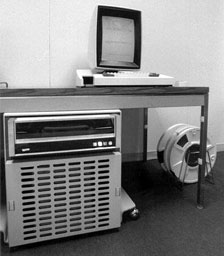 Since its inception, Xerox had given other companies tours of PARC, showing off the highly advanced Alto workstation, which had a bitmapped display, an object oriented programming environment, was networkable, and was more powerful than most minicomputers of the day. (The researchers at PARC had since become leery of outsiders, and stopped giving tours.)
Since its inception, Xerox had given other companies tours of PARC, showing off the highly advanced Alto workstation, which had a bitmapped display, an object oriented programming environment, was networkable, and was more powerful than most minicomputers of the day. (The researchers at PARC had since become leery of outsiders, and stopped giving tours.)
Convinced that the technology at PARC could help Apple usher in the eighties, Steve Jobs offered Xerox a killer deal. Apple, which was privately owned at the time, would allow Xerox to invest $1 million in Apple, which was sure to soar in value when the company went public in 1981 - in exchange for two guided tours of PARC's technology. Xerox happily accepted and gave Steve and a team of engineers from the Lisa project a tour.
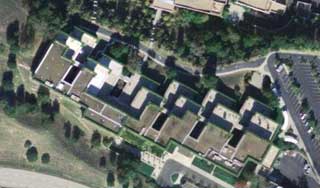 Steve Jobs (who took only Bill Atkinson along on his first visit) had a rather limited understanding of technology and was most impressed by the graphical interface he saw running on the Alto. The interface was not similar to today's interfaces, but it was a huge jump forward from the command line interfaces used everywhere else.
Steve Jobs (who took only Bill Atkinson along on his first visit) had a rather limited understanding of technology and was most impressed by the graphical interface he saw running on the Alto. The interface was not similar to today's interfaces, but it was a huge jump forward from the command line interfaces used everywhere else.
When the engineers returned, they had a vision of what they wanted in the Lisa project. The Apple chairman was so impressed that he interrupted a demo given by Xerox's Larry Tesler, asking him why nothing was being done with the technology.
For the second visit, Jobs brought along several members of the Lisa project and was given a much more technical demonstration. The other engineers who went on the second visit, who were briefed by Jef Raskin before their visit, were equally impressed.
The Apple engineers were not the only ones impressed by the visit. The researchers at Xerox, long discouraged by Xerox's inability to release a product based on the technology developed at PARC, were impressed by Apple's seeming willingness to implement advanced technologies in their products.
The Lisa project changed dramatically. No longer was it to be a mere hardware upgrade to the Apple II line. The new focus of the Lisa project was software. The team wanted to implement all of the innovations they saw at PARC.
Trip Hawkins, the marketing and planning manager for the Lisa project, rewrote the product specification to include a graphical user interface, a mouse, an object oriented user interface, and networking, as per Jobs' wishes. With the revitalized Lisa project, PARC researchers began to jump ship en masse to work on Apple's project. The first was Larry Tesler, who would be joined by 15 other Xerox employees before the release of the Lisa.
Bill Atkinson left the two PARC visits with an idea for the Lisa. While Tesler was giving a demo, Atkinson thought he saw that the Alto was displaying overlapping windows and was baffled at how the feature was implemented without sacrificing performance. This set off a multi-month obsession to find out how Xerox had implemented the feature, only to be interrupted by an auto accident.
Atkinson implemented overlapping windows and later found out that the PARC developers had never even considered implementing such a feature; there was no need to. All of this was implemented long before there was a fully functionally Lisa prototype.
Jobs took a more and more active role in the Lisa project, and he eventually appealed to Apple CEO, Mike Scott, to appoint him head of the group, displacing the well qualified John Couch. Scott had little confidence in Jobs' management abilities and did not want to put him on such an important project, so he kept Couch in control.
Jobs did not want to take the "consolation prize" of company spokesman, a position he was more qualified for than project manager, and eventually took control of the Macintosh project from Jef Raskin, where he maintained a grudge against the Lisa until it was discontinued.
The first and most important task of the team did not involve software at all. The group decided that a 16-bit processor would be necessary to power the bitmapped display and other processor-intense interface features. After considering several different processors, including the 8088 and Z8000, the team decided to use the Motorola 68000, a chip that provided performance comparable to a mini computer.
A more problematic decision was the floppy drive. While Jobs was still with the project, he insisted that the Lisa use Apple's "Twiggy" floppy drive. The unusual drives were very unreliable, but the engineers decided to keep them, assuming the reliability issues would be solved.
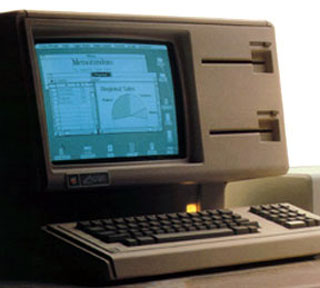 The Lisa was to be housed in a very approachable (almost cute) case. The CRT and CPU were housed in the same case, which had two feet protruding from the front. The innards were very accessible. The mainboard was mounted in a rack that allowed users to pull out the entire thing after taking out three screws, making it easy to service it.
The Lisa was to be housed in a very approachable (almost cute) case. The CRT and CPU were housed in the same case, which had two feet protruding from the front. The innards were very accessible. The mainboard was mounted in a rack that allowed users to pull out the entire thing after taking out three screws, making it easy to service it.
For all the innovation at PARC, Xerox's software was bewilderingly difficult for computer novices to use. Lisa' engineers were not interested in duplicating the Alto's software features. They wanted to extend and add on to them.
The Alto was still just a multi-million dollar prototype. The key differences between the projects was the Lisa team's dedication to ease of use. After a major interface feature was implemented, Larry Tesler would always recruit an initiated Apple employee to test it out. If the employee could figure it out, it stayed; if the employee could not, it was redesigned.
The principle difference between the Alto and the Lisa was that the Lisa had a desktop interface. Dan Smith, a major contributor to the desktop interface, had created the Lisa's first interface, the Filer. The Filer asked a user a series of questions about what task the user wanted to accomplish, and when enough questions were answered, the tasks were executed and the Filer shrank to the background. The entire operation was very fast for experienced users, but it tripped up the type of customers Apple hoped to win with the Lisa - those who were not already computer users.
Dan Smith realized this when he brought a Lisa prototype home and showed it to his wife. She was completely stumped by the Filer, and Smith knew that he had a problem.
This was mid-1982, and Smith feared that there would not be enough time to implement a new user interface. When he brought his problem to Bill Atkinson, Atkinson had an idea. Instead of involving the project's management, he recruited another engineer, Frank Ludolph, to spend a weekend at Atkinson's home in an extended crash session. By Monday morning, a preliminary version of Desktop Manager was ready for review by Atkinson's boss, Wayne Rosing, who was thrilled with the change.
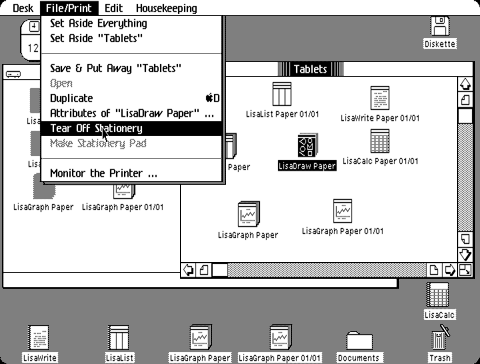
Desktop Manager's most notable difference from its peers (and most computers today) was that it used a document-centric interface. Users never opened or closed applications; they opened documents or created new ones from stationary. When users were done with a document, they would put it away, and the document would minimize to the file icon. This made the machine much more approachable by those who did not understand the concept of files or applications.
The biggest investment Apple made in the Lisa was not into the operating system, it was into the large suite of applications every Lisa shipped with. More than half of the software developers worked on perfecting the office suite that would be the focus of most users while they used their Lisa.
Seven applications, dubbed the Lisa Office System, were bundled with the operating system: LisaWrite, LisaCalc, LisaList, LisaProject, LisaDraw, LisaPaint, and LisaTerminal. All of these applications took full advantage of the document-centric the Lisa interface, and they were held in better regard by reviewers than the Lisa operating system itself.
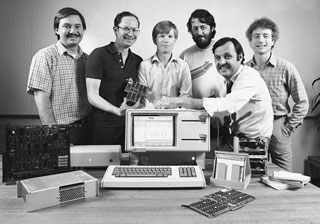
By 1983, the Lisa was ready. The marketing department planned a huge publicity campaign (one that would be dwarfed a year later with the Macintosh) that pushed the Lisa onto the national stage. Time and Newsweek did big write-ups on Apple and the Lisa. Advertisements were taken out in large trade magazines and newspapers touting the Lisa revolution.
By June it had all reached a fever pitch, and the Lisa was released. The price was set at $9,995, unheard of at the time, but necessary in John Sculley's eyes to recover the millions of dollars invested in the machine. (Sculley had recently been recruited as CEO by Steve Jobs.)
For the latter half of the year, the Apple met Lisa sales expectations and sold 13,000 computers. But in 1984, when Apple expected to sell 80,000, the company sold only 40,000, and sales would drop even further behind in 1985.
The biggest reason was price. The software and hardware was spectacular when compared to even the highest end PCs (even if the Lisa was a little sluggish), but the Lisa was priced well out of their range and had to compete with Wang, DEC, and Xerox - not to mention Apple's own Macintosh, which was released in 1984.
Apple was trying to sell a workstation like a personal computer.
By 1986, after several revisions and price cuts, the Lisa was discontinued.
Screenshots courtesy of ToastyTech.
Did you find this page helpful or enjoyable? If so, click here to support Low End Mac.
Recent Orchard articles
- A history of Apple's Lisa, 1979-1986, 10.06. Originally envisioned as a business computer to replace the Apple II, the Lisa brought the mouse and GUI to the computer market - only to be felled by the less costly Macintosh.
- Andy Hertzfeld: Mac truly a better way, 09.13. A key member of the Mac development team talks about the Mac, personal computing, the power of the network, and the future of free software.
- IBM, Apple, RISC, and the roots of the Power Mac, 08.01. How IBM's RISC project became the heart of the Power Mac.
- More in the Orchard index.
source:http://lowendmac.com/orchard/05/1005.html
European satellite presumed lost
| By Helen Briggs BBC News science reporter, Frascati |
| | |
The European Space Agency probe lifted off at 1902 local time (1602 BST) from the Plesetsk Cosmodrome in Russia.
Russian space officials said the flight broke up and crashed into the sea, but Esa has not yet confirmed it.
The £90m (135m euro) mission was designed to monitor how climate change was affecting the Earth's ice masses.
Early signs suggested the launch had been successful, but the satellite went missing some 90 minutes later.
Chief scientist Duncan Wingham of University College London said the mission was either lost or in an unknown orbit around the Earth.
He said: "Space is a risky business, it always has been.
"If we're lucky we might be in an orbit we could recover from. Until they locate it, we won't know."
| | |
The rocket, which in the Cold War would have been armed with nuclear weapons, had been modified for peaceful space duties with the addition of a Breeze-KM upper stage.
Dr Matthias Oehm, chief executive officer of Eurockot, said they had not received the expected signals from either the spacecraft or the upper stage of the rocket that should have injected it into orbit.
"This is not a positive sign for the success of the mission," he told a news conference at Esa's European Space Research Institute, in Frascati, near Rome.
Mission scientists had gathered there to watch the launch via satellite link from Russia. They clapped and cheered as the rocket was seen clearing the launch pad in a cloud of smoke. But their jubilation was short-lived.
| | THE EARTH'S ICE COVER Two types of polar ice: The ice that covers land and the ice that floats on the sea The large Greenland and Antarctic ice sheets cover 10% of the Earth's land area Surface measurements and overflights suggest Greenland's ice is undergoing melting Data from the Antarctic points to melting at the edges and some growth in central regions Considerable thinning of Arctic sea ice has been recorded by nuclear subs since the 1950s Observations from space are more extensive, but overall there remains a paucity of data |
Volker Liebig, director of Earth Observation Programmes at Esa, said he could not say for sure that the mission was lost, as there was still a chance that a signal from the spacecraft would be received.
"We just don't know what has happened," he said.
Ground-based radar and tracking stations are now searching for Cryosat.
One possibility is that the spacecraft has broken up in orbit and fallen into the ocean. In this scenario, the satellite would burn up in the Earth's atmosphere.
Mr Liebig said there was "no real danger" that it could cause damage on descent.
Cryosat was the first of Esa's so-called Earth Explorer missions. These are relatively low-cost projects that seek quick answers to some important environmental questions. In the case of Cryosat, the quest was for some definitive data on the behaviour of polar ice.
Previous satellite measurements, submarine and surface readings point to rapid melting in some areas, particularly in the Arctic Ocean where the extent of summer ice reached a record minimum this year.
Leonardo Da Vinci's Personal Notebook
source:http://science.slashdot.org/article.pl?sid=05/10/08/1258226&tid=146&tid=14
Moving from a Permanent Position to Contract Work?
source:http://ask.slashdot.org/article.pl?sid=05/10/07/234205&tid=187&tid=156&tid=98&tid=4
